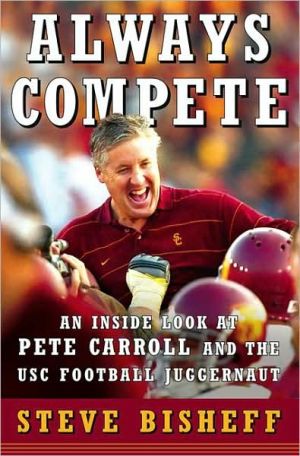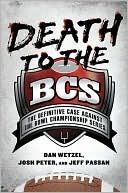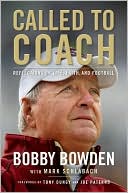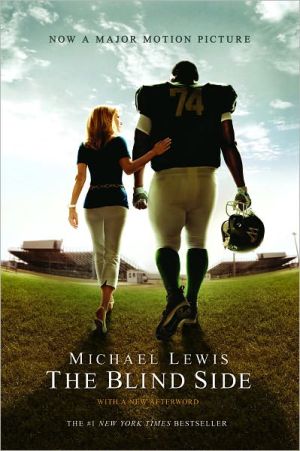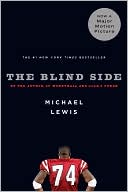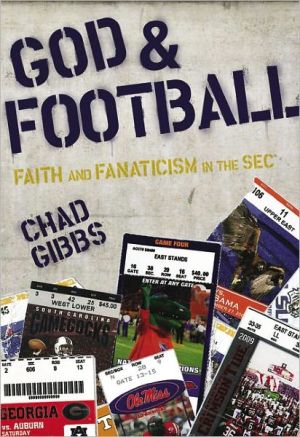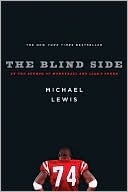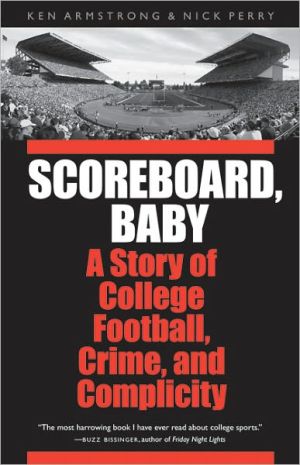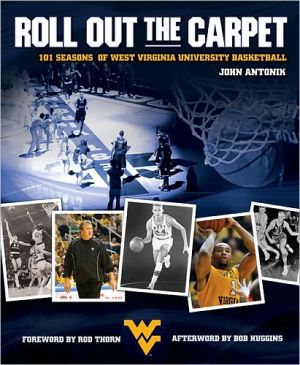Always Compete: An Inside Look at Pete Carroll and the USC Football Juggernaut
Just when USC football was in the midst of a horrific slump, when skeptics began to say the scholarship limits had conspired to make it impossible to recapture its old glory, Coach Pete Carroll arrived to transform and invigorate the program with his own bristling energy and style. He quickly reestablished the Trojans not only as the dominant college football team in the Pac-10 but as the preeminent program in the country, and the most entertaining team in the sport.\ In the past seven years,...
Search in google:
Just when USC football was in the midst of a horrific slump, when skeptics began to say the scholarship limits had conspired to make it impossible to recapture its old glory, Coach Pete Carroll arrived to transform and invigorate the program with his own bristling energy and style. He quickly reestablished the Trojans not only as the dominant college football team in the Pac-10 but as the preeminent program in the country, and the most entertaining team in the sport.In the past seven years, Carroll has captured two National Championships, made an NCAA-record seven BCS bowl appearances, and produced three Heisman Trophy winners as well as more than thirty NFL draft picks, including seven in round number one.For the first time ever, author Steve Bisheff has been given exclusive access to coaches and players, their meetings, practices, and locker room, as well as one-on-one interviews with Coach Carroll himself. Always Compete is both a revealing look at the tactics and personality of one of college football’s best coaches and a thrilling chronicle of the 2008 Trojans quest for another championship, culminating in their victory over Penn State in the Rose Bowl.
ALWAYS COMPETE\ I\ Excitement Amid a Fragile Spring\ It is one of those almost-too-good-to-believe, 75-degree Los Angeles afternoons in late March, and the usual large, cardinal and gold-clad crowd spills through the sun-splashed gates at Howard Jones Field for the first day of USC spring football practice. The veterans among the spectators are dressed comfortably but are carrying Windbreakers or sweaters, well aware that the brisk spring winds will come rattling in about the same time the early evening shadows creep onto the manicured lawn before practice is over.\ The head coach doesn't seem concerned with any of that. Pete Carroll, wearing a thin, white, form-fitting, long-sleeved shirt and khaki pants, sprints onto the field, clapping and chirping, flashing a smile as wide as the L.A. Coliseum tunnel. Carroll, with his face seemingly more tan than ever and his gray hair blowing in the breeze, looks like a kid who can't wait to open his new, giftwrapped PlayStation 3. His bouncy enthusiasm is infectious, and several of the players look up and grin at him as they begin their calisthenics.\ Thanks to Carroll, USC football is an institution again in L.A., the happy, winning substitute for the nation's No. 2 marketthat is still incredulously without an NFL franchise. Instead of Rams or Raiders merchandise, everyone can now be seen wearing USC gear at the malls and theaters and casual restaurants around this sprawling megalopolis. The Trojans have become the city's biggest winners, more consistent than the Lakers, more successful than the Dodgers, and clearly overshadowing the basketball exploits across town at UCLA.\ It is not just all the winning, it is the style and caliber of players he has developed at USC. In his first seven years on the job, Carroll produced thirty All Americans and eleven first-round NFL draft picks, including four in the 2008 draft. It is a remarkable record, and the steady stream of victories has created a rare comfort zone for Carroll, who seems to tease the USC faithful every off-season by listening to an assortment of NFL head coaching offers. Few, if any, college coaches have less job pressures than he does. Still, you can sense a rustle of discontent from some boosters and alumni who have been spoiled by all the Trojans have achieved. They point out it's been four years since they won their second of two national titles under Carroll and three years since they've been back to the BCS Championship Game. They're hungry to wave those large cardinal colored foam fingers in the air and proclaim "We're No. 1" again.\ Last season ended much like the one in 2006, with USC semi-grudgingly accepting a bid to the game that once was its ultimate goal, the Rose Bowl, where it systematically whipped yet another overmatched Big Ten opponent, this time Illinois. Back-to-back, 11-2 bowl-winning seasons would be cause for celebrations at most universities, but not here, where the bar has been raised to a whole different level. Maybe that's why there is an undercurrent of uneasiness about the start of this spring practice. Or maybe it's just the fact that, for the first time since a tall, left-handed kid named Matt Leinart squeezed out the job at the end of spring, the Trojans aren't sure who their quarterback will be in the opener at Virginia on August 30.\ Once Leinart took control as a sophomore, he held onto the position for three glory-filled years, going 37-2, leading the teamto those two national titles and winning the Heisman Trophy along the way. When he left for the NFL, everyone knew that John David Booty, who'd been waiting patiently, would take over. Booty quarterbacked the team for two seasons, and although he never matched Leinart, he had a nice, two-year run, losing only three games he started and directing the team to consecutive Rose Bowl victories.\ Now, at least publicly, Carroll and his coaches are saying the job is open. "We want to take our time, and hopefully get a real sense of someone we can count on at the position," Carroll tells me in our first real one-on-one interview of the season. "We want to do it right. We're not necessarily going to go for the biggest, strongest arm. We'll go for the quarterback we think will help us win."\ Still, those who've been around the program the longest quietly believe the choice has all but been made already. They have come to trust Carroll and his instincts. They should. He picked Leinart over Matt Cassel, the backup to Tom Brady who eventually took over when Brady was injured with the New England Patriots, even when the two quarterbacks were basically even coming out of spring practice. He said he sensed something special in Leinart. Whether he senses the same thing in Mark Sanchez is difficult to know, but one thing is clear: Carroll has never had a quarterback controversy in his previous seven years at USC, and he certainly isn't looking for one now. So the sense is that Carroll wants Sanchez, the fourth-year junior who's been around the program for three seasons, to win the job, despite the challenge he knows is coming from flashy Mitch Mustain, the much-hyped transfer from Arkansas.\ Around the rest of the country, on ESPN and in most L.A. area newspapers, this has been proclaimed as the hottest spring quarterback duel in college football. These are, after all, two kids who were national prep players of the year their senior seasons in high school. Most of the ardent boosters and alums think this is about which of the two quarterbacks proves to be a better leader and more accurate, mistake-free passer. In the quiet reality of theUSC coaching chambers, however, it's about more than that. It is about a philosophy and some off-the-field politics that are understood but never openly discussed, even in the staff's private meetings in Heritage Hall.\ Carroll values experience more than anything else, and Sanchez has spent much more time learning the offense than Mustain, who was the scout team quarterback, running opponents' offenses, not USC's, in his first year after transferring from Arkansas. Then there is the potential recruiting fallout involved. Sanchez is from the same rich Orange County pipeline that produced Leinart and Carson Palmer, another Carroll-coached Heisman Trophy winner. Already, the next highly decorated Orange County quarterback, Mater Dei's Matt Barkley, the national prep player of the year as a junior, has committed to USC. Carroll has to be careful not to do anything that would besmirch his reputation among future SoCal quarterback prospects, like maybe choosing a transfer from Arkansas over a highly regarded local kid who had been waiting three years for his chance.\ So, although Carroll keeps insisting the position is wide open, it's clear early on in the spring that it is Sanchez's job to lose. The only way he wouldn't be named the starter at the end of spring practice was if, one, he completely screwed up, or, two, Mustain was so spectacular that he thoroughly outplayed him. Both of those options were long shots, especially since the plan was for Sanchez to take 80 percent of the practice snaps with the first-team offense, while Mustain and Aaron Corp, still another Orange County hotshot, would split time taking the majority of their snaps with the second team.\ Steve Sarkisian, Carroll's bright, young offensive coordinator, smiles and talks about how much he likes all the quarterbacks, but when you press him, he shrugs and admits what most already know. "Yeah, I'd have to say Mark is ahead going into this," he says, "but we're excited to see what they can all do." What makes this quarterback choice more intriguing is that it's the first time Carrolland Sarkisian have had to make a decision of this magnitude since Norm Chow, the former offensive coordinator, left to accept the same job with the Tennessee Titans. Widely regarded as an offensive genius, at least at the collegiate level, Chow molded both Palmer and Leinart into Heisman winners and did the same for Ty Detmer at BYU. He left USC under a smoggy cloud of controversy when Carroll wanted to move him, or, as Chow's friends contend, "demote him," to quarterbacks coach, taking away his cherished role as a play caller.\ The Trojans's program under Carroll seemed at its pinnacle when the head coach was directing the defense and the creative Chow was calling the plays on offense, although the presence of Leinart and Reggie Bush, still another Heisman winner, obviously had something to do with it. Chow had a strong voice and he wasn't afraid to use it, even if he disagreed with Carroll or others on the staff. Some felt it was the kind of creative tension that made everything work on offense. Others weren't so sure. Whatever was going on, the tenseness had begun to grow on the coaching staff. What happened from there still remains somewhat fuzzy. Some felt Chow started receiving what fellow staff members felt was a little too much credit in the media for the offense. At the same time, the role of Lane Kiffin, a young, ambitious assistant and son of Carroll's best friend, Tampa Bay defensive coordinator Monte Kiffin, started to magnify. Carroll wanted the thirty-something Kiffin, who starts this season as the Oakland Raiders head coach, to have more input in the offense, and Chow quietly, or not so quietly, resented it.\ Before this season, and this book, is finished, I intend to get Chow and Carroll to corroborate what really happened, what led to Chow departing for the NFL Tennessee Titans, and Carroll moving Kiffin up and hiring Sarkisian, naming them co-offensive coordinators, putting his own stamp on the offense and limiting Chow to work in some other capacity. When that occurred, the writing was on the locker room wall. Everyone knew Chow would accept the first good offer to come along.\ When it happened, when Chow was named offensive coordinator of the Titans, Carroll was effusive in his praise of Norm in comments to the media, and Chow talked glowingly of how much he enjoyed his time with Carroll and the Trojans. Those who had been close to the situation, however, understood that it had not been an amicable separation, even if no one would talk about it publicly. For weeks afterward, you could still feel the bitterness lingering in Chow's old office on the second floor of Heritage Hall, not to mention the anger from some Trojans alums, many of whom still believe USC never would have lost that BCS title game shoot-out with Texas the following year if Chow had been calling the plays.\ Three years later, in a bittersweet twist of irony, Chow, who had been relieved of his duties in Tennessee, accepted the offensive coordinator's job at UCLA, USC's intense crosstown rival. He'll now be working with a fiery new boss, former Bruins quarterback hero Rick Neuheisel, in Westwood, where UCLA fans are quick to remind their Trojan friends that they haven't been to the national championship game since Chow left.\ So now the shadow of Chow is hovering even closer, as Carroll and Sarkisian go about picking the quarterback they hope will help them win when they have to play Chow and the Bruins in what is sure to be an emotionally charged game in December. For Sarkisian, maybe more than Carroll, the stakes are huge. He has evolved into one of America's high-profile assistants, and it was clear after he turned down the Raiders' head coaching job, which eventually went to Kiffin, that his goal was to be a head coach at a major university. First, though, he has to prove he can help the Trojans win a national title without Chow, who, interestingly enough, was his original mentor at BYU.\ To do it, Sarkisian and Carroll have to make the right choice at quarterback and then make sure whoever they choose plays within their framework. That becomes more and more evident as the practices progress on Howard Jones Field. As the spring days float by, it is almost as if Sanchez, an energized, enthusiastic, gunslinger typein the Brett Favre mold, is being kept under wraps. Equipped with the strongest arm on campus since Palmer's, he is spending much of his time throwing short, safe passes in practice, a quick slant here, a dump off to a running back there. The emphasis is not on making big plays, but on avoiding mistakes. The plan must be working, because the coaches are smiling and patting him on the back and praising him in the media sessions afterward.\ In the meantime, a strange thing is happening. Mustain, who senses he is the underdog in the competition, seems to be going out of his way to take chances. He is a pure passer, and he is consistently completing more balls downfield, particularly to Damian Williams, the exciting wideout who transferred from Arkansas with him. It's apparent the two of them already have a strong on-field rapport, but if the duel seems to be heating up, the coaches are quick to tone it down. Both quarterbacks have been carefully counseled to say the right things to reporters.\ "I think this is my job now, and I feel things are going well," says Sanchez, whose dark hair and swarthy features have had fans mistake him for Leinart in the past. "I'm just concentrating on making the right decisions." Mustain rubs a hand through his sandy hair and admits Sanchez is the frontrunner. "I'm just out here trying to learn and get better every day," he says. But every once in a while, in his attempt to be politically correct, he slips and lets the competitive fire show through. "I didn't come here to be a backup," he says at one point, then glances around nervously to make sure there aren't any coaches nearby.\ Although the quarterback battle is the focal point of the spring, Carroll has plenty of other things on his mind as March turns into April. Thanks to three years of extraordinary recruiting, his overall talent pool is as deep as ever, especially on defense, but he has to find a replacement for Sedrick Ellis, the All-American nose tackle who was his best football player in 2007, and he must address an offensive line that has only one starter returning. Then there is the always intriguing situation at tailback, where no lessthan six flashy candidates, almost all high school All Americans, will be competing for carries with another highly regarded addition due in the fall.\ None of this is anything new. There is always turnover to deal with in college football. Nevertheless, this particular spring has a sense of urgency attached to it, because the USC schedule, for the first time since Carroll arrived, is highlighted by a monumental early-season matchup. Usually, the biggest games Carroll's Trojans play are in November or early December. Not this time, though. This time, Ohio State will come to the L.A. Coliseum on September 13, in an intersectional that will have obvious BCS bowl implications, with the winner likely to be anointed No. 1 in all the early-season polls.\ "We won't treat things any different because of that game," Carroll says. "Our routine will stay the same." Maybe, but the Trojans want to be sure they have their best player starting in Ellis's old spot at nose tackle, and they certainly want to identify the starters in the offensive line well before the week of the Buckeyes' game.\ If tailback is a problem, it is a nice one to have. Any one of the six Trojans runners would probably start for crosstown rival UCLA and most of the schools in the Pac-10. They are that good. So Carroll is using the spring to get extended looks at some of his less experienced tailbacks, kids such as Allen Bradford, Marc Tyler, and Broderick Green. The likely fall starter, Stafon Johnson, is being used sparingly, while Joe McKnight, the most exciting of all the runners, is forced to miss the final couple weeks of spring practice for academic reasons, although no one expects that to be an issue come fall.\ For any of the tailbacks to have success, first the holes must be there. That's where offensive line coach Pat Ruel comes in. A ruddy-faced veteran of thirty-three years coaching in college and the NFL, Ruel is the prototype football lifer, with a thick moustache and a gravelly voice that some of his linemen must still be hearing when they go to sleep at night. With only one starter back from a year ago in All-American candidate Jeff Byers, Ruel's challengewould seem immense, especially at a school where the pressure is as thick as the often smoggy air. But Carroll never goes into a season caught short at any one position, and he and Ruel are comforted by the fact that several of his linemen not only played extensively but extremely well when injuries hit the line like an unsuspected tsunami a year ago. Kristofer O'Dowd, now a sophomore, was stunningly effective early, subbing for the veteran Matt Spanos at center. Quietly, Carroll and Ruel believe he will be a star. At the other spots, kids like Charles Brown, Butch Lewis, Zack Heberer, Alex Parsons, and Nick Howell all have a chance to be solid college players. Then there's Thomas Herring, the 340-pound monster with quick feet who isn't as mature as the others but has more potential than any of them. "If that kid could ever get it together, he could be unbelievable," Carroll says to a couple of cronies on the sideline one day. "Yeah," admits Ruel, when asked about Herring, "his ceiling is pretty much unlimited. But he's got a ways to go yet. He's not as advanced as some of our other guys."\ For everything else going on, though, the spring still comes back to the quarterbacks. Two weeks away from the end of practice, in a weekend scrimmage, Sanchez, still playing conservatively, moves the offense but does little to stand out against the first-team defense, while Mustain, working mostly against the second-team defense, throws three touchdown passes. Immediately, the Internet chat rooms come alive with talk that Mustain is about to supplant Sanchez as the starter. The whispers on the practice field after the scrimmage convey the same message.\ Carroll senses it, and on the next practice day the following week, he makes the most revealing move of the spring. He orders that Sanchez be given all the snaps with the first team, every single one, limiting Mustain and Corp to working only with the second team. It is as if Carroll is sending a message: It doesn't matter what happened in that weekend scrimmage. Sanchez is our quarterback. Confronted by the media after the Tuesday practice, Sarkisian calmly explains that "nothing has changed." He insists Sanchez always gets the majority of the snaps, but the reporters knowotherwise. They begin writing in the next day's newspapers that the quarterback duel is over. Sanchez has won. A week later, Carroll makes it official. He names the junior as his starter going into the fall.\ The announcement takes some of the drama out of the "Trojan Huddle," the name that has been given to the old spring game, the final scrimmage that marks the end of spring practice. It doesn't matter in Trojan-mad L.A., though, where some 22,000 people show up at the Coliseum on a cool April Saturday to catch a glimpse of what their beloved Trojans will look like in the fall. The game features lots of offense, with Sanchez making up for an early interception on a rare flea-flicker play to complete 16 of 24 passes for 203 yards and 3 touchdowns, including one on the only long pass the coaches allow him to throw, a beautiful 37-yard spiral that floats gently into the hands of wide receiver Ronald Johnson. Mustain completes 6 of 10 passes for 111 yards and 2 touchdowns in a less-than-impressive showing.\ The real surprise of the scrimmage is Corp, the redshirt freshman who wasn't even in the quarterback picture most of the spring. He isn't just good on this day; he is spectacular, completing 13 of 16 passes for 158 yards and 2 touchdowns, including the one in overtime that gives his team the victory. In fact, if you'd just walked into the Coliseum not knowing anything about the team, you'd have thought Corp was the most experienced quarterback of the group. He was that poised and relaxed, and afterward, even Carroll admitted his surprise. "Aaron got into a really nice groove," he says. "He played with a lot of confidence."\ Carroll says he was impressed with the team's energy and its overall speed, and talks as if he was pleased with the way the scrimmage went. Still, as much as he wanted to establish the clear frontrunner at quarterback and give him momentum heading into the summer, the last thing he expected, on the final day of the Trojans' spring, was for Sanchez to be overshadowed by a red-shirt freshman.\ "Oh well," says one prominent USC alum watching from a privileged spot on the sideline, "if nothing else, this should make for a lively first few weeks of practice in the fall."\ Maybe a little too lively for Pete Carroll's taste.\ Pete Profile\ The Quiet Activist\ \ \ \ Four weeks to the day before USC's season opener in Virginia, on one of those broiling Los Angeles Saturdays in early August, you'd think Pete Carroll would be sequestered in his air-conditioned office, poring over film or drawing up complex defensive schemes. But he is not.\ He is strolling down Martin Luther King Boulevard, just in front of the Trojans' home, the L.A. Coliseum, trailed by several TV cameras, a couple of out-of-breath announcers, a pair of Internet reporters, and me. I'm grasping my notebook and trying not to smile, because it appears I'm in somewhat better shape than the younger TV guys. Directly behind us is an animated crowd that grows to somewhere between 1,500 and 2,000 people who are part of the LA LivePeace March and Rally. It is hosted by the nonprofit foundation that is near and dear to Carroll's heart, A Better LA, and UNITY ONE, two groups dedicated to promoting nonviolence in the streets of Los Angeles and raising public awareness regarding the community efforts toward gang intervention.\ Carroll is walking, sometimes by himself up front, sometimes holding hands with his proud wife, Glena, but always smiling and waving to the bystanders and the startled people in their cars heading in the opposite direction on Martin Luther King Boulevard. "No moreviolence!" chants someone in the crowd behind him with a loudspeaker and microphone. The crowd repeats the chant. "Save our kids!" the gentleman shouts next, and again the crowd repeats his words. "Save our babies!" he screams, and the rhythmic words echo across the warm L.A. pavement.\ Carroll is joined by L.A. sheriff Lee Baca, City Councilman Bernard Parks, and San Francisco mayor and magazine cover-boy Gavin Newsome, along with Newsome's new blond bride. But there is no mistaking who the celebrity is on this sun-splashed summer day. Beginning with a brief, premarch press conference emceed by Yogi Roth, Carroll's graduate assistant coach and all-around PR front man, in the shadow of the Coliseum's famous peristyle end, Carroll cannot take two steps in any direction without getting swarmed. People want to shake his hand, or ask for an autograph, or pose him for a picture with somebody's son or daughter or entire family. If you didn't know better, you would think he was the politician running for office in the group. The people, mostly African Americans and Latinos who live in the surrounding area, look at him adoringly, obviously appreciative that this big-time coach, maybe the most famous college football coach in America, would take time out of his busy schedule to do this for a cause they deeply believe in.\ "His job is to be a football coach," says Parks, the councilman who was once the city's police chief. "He doesn't need to be out here saving lives. But here he is, helping, trying to get people jobs. I've always believed that the one thing that stops a bullet faster than anything else is a job." Not all the bullets get stopped, though. Only a few weeks earlier, Jasmine Sanders, an innocent eight-year-old playing in the streets of South Los Angeles, was gunned down by a stray bullet from a gang member's gun. Ironically, her funeral is scheduled to be held just a few miles from the rally later in the day.\ Another innocent victim, a promising, young high school football player named Jamiel Shaw, was murdered a few months earlier just walking to a store in the same dangerous part of South L.A. His grieving parents are in the middle of the march, holding up a picture of their son in full football uniform. When you glance back at them for asecond, you see tears welling in their eyes. Newsome, a politician who is supposed to have a bright future, said that's why he made the four-hundred-mile trip from San Francisco to Los Angeles. "It's inspiring to me, because the Northern California challenges are the same as the Southern California challenges. It seems every week a fifteen-year-old is killed by a sixteen-year-old with a gun. Someone is gunned down all the time in the streets of the inner city. America is the war we really have to win."\ So Carroll, the coach who has become successful because he is consumed by winning football games, has quietly turned that same energy and drive into something he considers even more important. "It took somebody like Pete Carroll to say we can do better," says Bo Taylor, who founded UNITY ONE, the violence-prevention nonprofit that works closely with Carroll's A Better LA. "It just shows what can happen if we work together for something positive."\ Taylor is the former gang member who became somewhat famous for taking Carroll along on a series of midnight rides through the 'hood in L.A. On this day, he is visibly struggling with his health. Carroll reveals his friend has been diagnosed with inoperable cancer. "He hasn't got much time left," he says. "He's an amazing guy." (Less than two weeks later, Taylor dies from the disease).\ As Carroll marches, he notices me walking alongside, notebook in hand, and tries to put into words his goal. "What we want to develop," he says, "is that feeling that you can do it. You can cut down on the violence if you focus on it day by day, week by week, month by month. It's such a long process, but you try to help just by doing the right thing. We're seeing innocent bystanders being victims, where a few people wind up frightening a lot of people. It is a handful of people causing all the problems, and part of that has to do with economics. What's obvious is that everybody is scared, but if you can give them a legitimate way to turn their lives around, they'll listen."\ Fifteen minutes later, the march snakes its way down a side street and into the huge Coliseum tunnel. As marchers stroll out into the sunlight again, volunteers are waiting with cold drinks and encouraging shouts. Most of the members find their way to seats at the closed endof the historic old edifice. After everyone drinks and tries to cool off, Carroll steps up to the microphone.\ "It's no accident we're here in the Coliseum today," he says. "It's a place with a history of extraordinary championships, and it's no coincidence that we're trying to win and win in a big way. If all of us continue to work at it, we can do this." The subject is not something Carroll has a casual interest in. Listening to him talk a few minutes later, he sounds as emotional as he does the week his team is about to play crosstown rival UCLA. "We're seeing innocent people becoming victims," he says, "and the effect it has on everyone is very much like terrorism. It's a few people who cause the problems, but there are reasons behind that. The thing is, everybody is scared. Many of the gang members are charismatic, high-level-thinking people who run the gangs themselves. Those guys would do anything to change it if they could, but they're just in survival mode. We need to find some way to turn their lives around. If you tell them that's possible, they'll listen. We've talked to a lot of the leaders of the community, and we believe they're going to help. That's exciting to see. This needs to be an emotional movement from the inside out of these communities. If it isn't emotional, we aren't going to get their attention. We need to focus on those who can help us create change."\ The midnight rides Carroll has taken through the mean streets of L.A., initiated with the late Taylor and chronicled in newspapers and magazines, as well as on CBS's 60 Minutes, have become something of an urban legend. "It was crazy; people couldn't believe I would be out there at first," Carroll says. "They were always coming up to me and saying what are you doing here? But then we'd laugh and everyone would relax and they'd talk about some of their problems and what we could do to help.\ "My goal in doing that is just to let them know someone is thinking about them. They have to know they're not alone. A lot of them think they have only two choices: to go to jail or to die on the streets. Somehow, we have to change that. We have to let them know there are other options they can take with their life. We're trying to get them jobs when we can. We had one kid named Diamond who was a gang member,and we helped find him a job, and now he's turned his life around and he's working and staying out of trouble and even working with our foundation to help others like him."\ Carroll got the idea for A Better LA after a conversation with Lou Tice, a longtime friend and founder of the Pacific Institute. They'd always talked about doing something worthwhile for the community, and after one particularly heart-wrenching week of crime and death in the streets, Carroll called Tice. "I told him we need to figure out what to do," Carroll says. "We need to get involved and do something to keep these kids from killing each other." So Carroll and Tice, along with several others, established A Better LA, with the intent to change the gang culture in the area.\ Someone once asked Tice if Carroll was as laid-back as he appeared. "Yeah," said Tice, "he's laid-back—laid-back like a ninja ready to strike." Carroll's tireless work for the foundation was recognized in the spring of 2008 at a Summa Children's Foundation gala to honor Carroll. "While Pete Carroll may be best known for his victories on the field," said Brian Werdeshem, the Summa Foundation's cofounder, "his true success lies in his work to end gang-related violence affecting the inner-city communities of South Los Angeles."\ In many ways, his work was symbolized by the gala, where half of the proceeds that night went to Carroll's A Better LA. The total donated on that warm spring night? More than $750,000.\ This past winter, the USC School of Social Work presented Carroll with the Crystal Heart, the school's highest honor for community service. In an even more moving tribute to the Trojans football coach, it established a scholarship for students persuing graduate study at the USC School of Social Work. Fittingly, it will be called the Pete Carroll Scholarship.\ ALWAYS COMPETE. Copyright © 2009 by Steve Bisheff.
